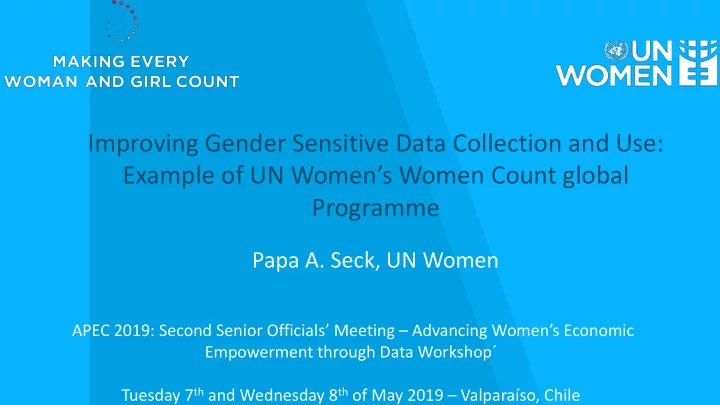

Improving Gender Sensitive Data Collection and Use: Example of UN Women’s Women Count global Programme Papa A. Seck, UN Women APEC 2019: Second Senior Officials’ Meeting – Advancing Women’s Economic Empowerment through Data Workshop´ Tuesday 7 th and Wednesday 8 th of May 2019 – Valparaíso, Chile
Challenges for Gender Data What actions are required to improve the production and use of gender statistics? 1. Weak policy space and legal and financial environment to produce gender statistics at national level – e.g. limited funding 2. Technical challenges within National Statistical Systems that limit the sustainable production of gender statistics – e.g. low skills levels 3. Lack of access to data and limited capacity on the part of policymakers and other users to analyse data to inform policies – e.g. low data literacy
Challenges for Gender Data What actions are required to improve the production and use of gender statistics? 1. Enabling policy environment for gender statistics Strengthen the policy and financial environment to enable gender-responsive national adaptation and effective monitoring of the SDGs 2. Increasing data production Quality, comparable and regular gender statistics are produced to address national data gaps and meet policy and reporting commitments under the SDGs 3. Improving data availability and use Gender statistics are accessible to all users and can be analysed to inform research, advocacy, policies and programmes, and promote accountability
Challenges for Gender Data 5-years, $60 million programme Projects in 12 Pathfinder Countries • 2018: Bangladesh, Kenya, Morocco, Nepal, Tanzania, Uganda • 2019: Albania, Cameroon, Colombia, Jordan, Senegal, Sierra Leone, Regional projects – regional collaboration and support on demand Global project and regular SDGs monitoring • Integrating gender in national statistics strategies (with OECD) • Joint programme on violence against women data (with WHO) Global Centre of Excellence on Gender Statistics (with INEGI/Mexico)
Example: Asia & Pacific regional project 1. Enabling environment for gender statistics • Support to localize SDGs and select priority gender indicators; Pacific Roadmap for gender statistics • Establish Intergovernmental group for gender and environment statistics 2. Increase data production • Support reprocessing of existing data (e.g. Vietnam & Indonesia) • Support new data collection (e.g. China & Mongolia) • Establishment of regional training network for capacity building 3. Improve data accessibility and use • Regional user-producer dialogues • Regional training (communicating statistics; dissemination etc.)
Responding to national priorities: e.g. Kenya What actions are required to improve the production and use of gender statistics? Kenya Vision 2030 Medium Term Plan III & Gender Sector plan (2018-2022) National Strategy for the Development of Statistics (NSDS) (2018-2022) United Nations Development Assistance Framework (2018-2022) Domestication of SDGs (34 indicators)
National assessment (2018) – key challenges Enabling Environment Data Production Data Availability & Use Use of existing data not Poor dissemination Political and structural always optimal disablers Limited collaboration Data gaps and old data in between users and Inadequate legislation to key areas producers allow for optimal coordination of statistical Inconsistency between Low data literacy activities classification/definition of data and SDG indicators & Limited in-depth Weak coordination at no meta databases secondary analysis and many levels policy research Capacity gaps of Low and ad-hoc funding producers
Progress 2017-2018 Enabling Environment Data Production Data Availability & Use LOAs with predictable funding Data reprocessing – Regular reporting (SDGs) Integrate gender in NSDS county level (w. Council of and NDP – aligned to Governors) In-depth analysis of national monitoring surveys New data collection – Ntl Technical assistance to Treasury COA; time use Forum for users and MDA, including agriculture survey producers Ministry Census monograph Grants to student for Strengthen national and Capacity Building & further research sub-national coordination Training mechanisms
Thank you!
Recommend
More recommend